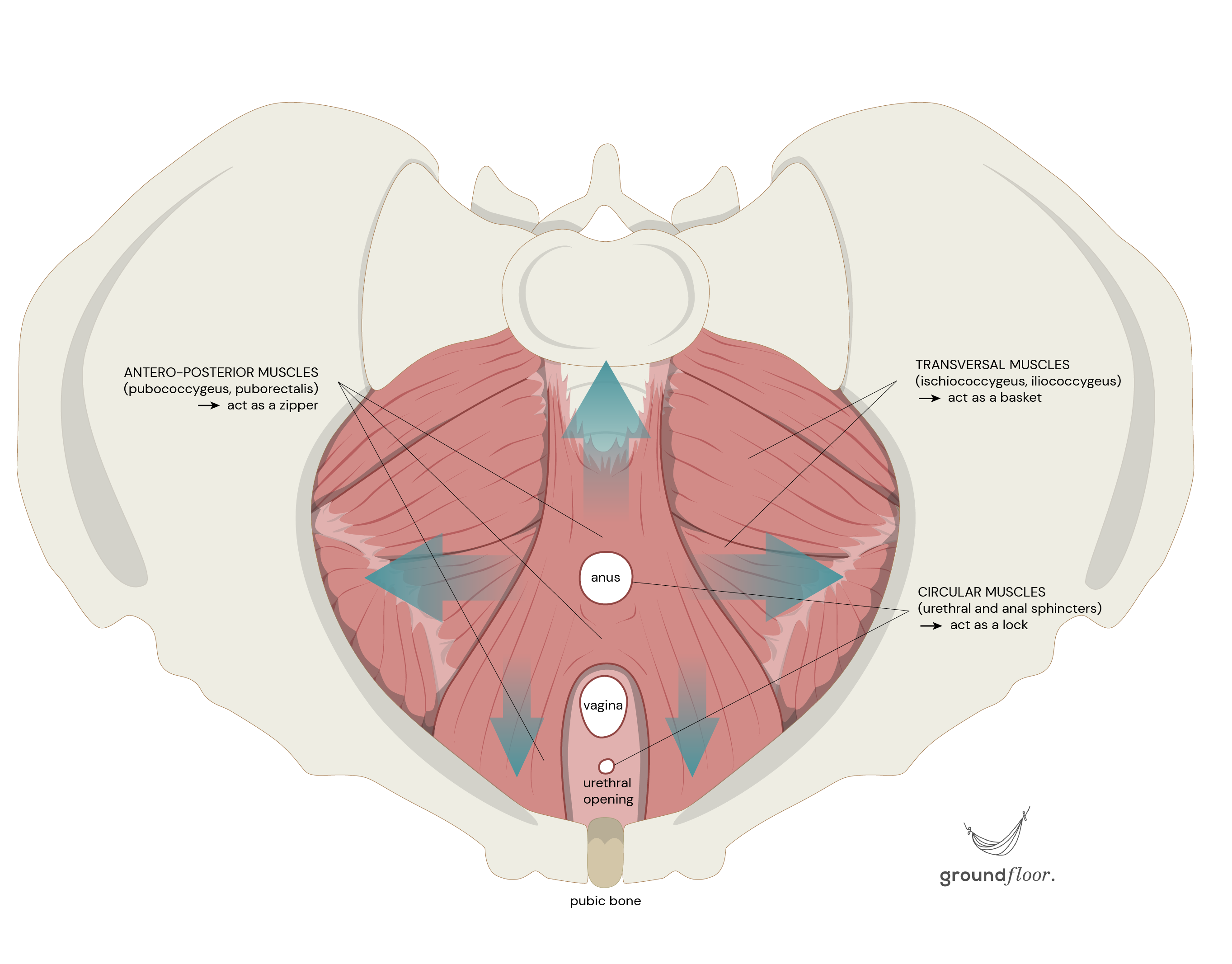
Too many people have limited knowledge about the pelvic floor and its purpose, often associating it solely with urine leakage or childbirth. However, the truth is that the pelvic floor encompasses much more than that.
In this article, we will simplify the complex concepts of pelvic floor anatomy, functions, and mechanisms of action. Our goal is to make it easier for you to understand and appreciate the importance of this vital structure.
The roles of the pelvic floor
The pelvic floor is a complex network of muscles, ligaments, fascias, and connective tissues weaved together to form a supportive sheet at the bottom of the pelvis. Its functions encompass supporting the pelvic organs and abdominal viscera, managing pressure within the abdomen, and participating in the respiratory mechanism.
It is better known for its « gate control » function, which controls the openings responsible for urinary, digestive, and sexual functions. These openings include the urethra (for urine passage), the vagina (for sexual intercourse, menstruation, and childbirth), and the anal canal (for stool and gas passage).
The anatomy of the pelvic floor muscles
We mainly refer to the muscles when we use the term pelvic floor because they are the part that we can consciously control through contraction and relaxation. We can divide them into three categories.
The puborectalis, pubococcygeus, and iliococcygeus together form the levator ani, the largest component of the pelvic floor. It makes up the deepest muscular layer, alongside the ischiococcygeus.
The more superficial layer consists of the bulbocavernosus, ischiocavernosus, and transverse perineal muscles. These muscles play a crucial role during sexual intercourse.
Finally, the sphincters are small circular muscles. During a contraction, they act as a locking mechanism, closing the urethra and anus.


What happens during a pelvic floor contraction?
It is nearly impossible to separate the contraction of one muscle from another as they share the same innervations (pudendal plexus from S2, S3, S4). They function as a cohesive unit. However, each muscle exhibits distinct activation patterns, determined by the specific demands of the situation and the state of the pelvic floor.
Indeed, the muscles with anteroposterior fibres, going from the back to the front of the pelvis, such as the puborectalis and pubococcygeus, function like a zipper. They "pull" the tailbone towards the pubis. They close the urinary, genital, and anal openings in coordination with the sphincters. These muscles need to contract quickly to effectively prevent accidental leakage from the bladder and bowel when there is an increase in pressure (during an effort or when you sneeze, for example).
On the other hand, the muscles with transverse fibres, like the iliococcygeus and coccygeus, span from side to side and act as a supportive basket. Their primary function is to provide support to the pelvic contents. Unlike the previously mentioned muscles, they do not require rapid contractions. Instead, they maintain a consistent and adjustable tension over a longer period. Their main role is to remain activated for an extended duration to fulfil their supportive function and keep the pelvic organs in place.

The biomechanics of the pelvic floor made simple
The actions of the pelvic floor can be simplified into two modes.
During a contraction, the pelvic floor elevates and becomes shorter and firmer, effectively securing everything in place. The sphincters tighten even more to effectively seal the openings and prevent the leakage of urine or stool. It is comparable to locking a door.
Conversely, when we relax our pelvic floor, it stretches and descends, creating space for movement in and out. The sphincters loosen, allowing the urethral opening and anus to get wider. It enables the outflow of urine, stool, gas, menstrual flow, and passage during intercourse and childbirth. It is comparable to opening a door.
A healthy pelvic floor must possess the ability to adapt to different situations. Want to urinate, have a bowel movement, or engage in intercourse? Open the door! Need to hold your bladder or practice high-impact activities? Keep the door closed!
Be proactive for a healthy pelvic floor
Unfortunately, improper use or neglect of your pelvic floor can give rise to various dysfunctions, compromising the proper operation of the functions described in this article.
However, the good news is that numerous options exist to address these issues. It is a false claim that pelvic floor problems are inevitable after pregnancy or as you age! It is never too late to take care of your pelvic floor, but it is better to start early.
Start by taking your free pelvic floor check-up to ensure your pelvic floor is not showing early signs of dysfunction. It will also assess the likelihood of developing issues over time.
Share this article with your friends and help spread the knowledge together! ↓
Share this article with your friends and help spread the knowledge together! →





Download the app to learn more about this topic and receive tailored information about your pelvic health!


Related articles

7 min read
The truth about having a tight pelvic floorA hypertonic or overactive pelvic floor (distinct from an overactive bladder) results from the buildup of excessive tension within the muscles. In this situation, the pelvic floor can also be referred to as "tight", which is often wrongly believed to be a good thing. This article will debunk this myth and shed light on the misconceptions surrounding this topic. Delving into the consequences of such a condition, we will also explore the common errors that can lead to a hypertonic pelvic floor and provide effective and practical strategies to address it.
→ Read more

10 min read
Unlocking pleasure: Your pelvic floor's secret to fulfilling sex!Experiencing pain during intercourse? Struggling with sensations or achieving orgasm? Contrary to common beliefs, many sexual dysfunctions are not psychogenic or hormonal in nature. Instead, they often stem from pelvic floor issues. This article will uncover strategies to improve your pelvic health while elevating your sexual life to unprecedented levels.
To start, we will explore the anatomy of the clitoris, its relationship with the pelvic floor, and their roles in the context of sexual activities. Then, we will explore prevalent dysfunctions and conditions that contribute to these challenges and provide insights into effective approaches for resolution. Finally, we will delve into the intricate interplay of physical, mental, and emotional factors within the multifaceted realm of sexuality.
→ Read more

3 min read
Turn on the automatic mode of your pelvic floorYou may have been training your pelvic floor wrong this whole time! One-size-fits-all exercises can't unlock the full potential of your pelvic floor. This article will discuss why tailoring your training is crucial to target your specific needs. You will also learn about the Knack, the alternative to doing Kegels forever, that will make your pelvic floor work automatically!
→ Read more

